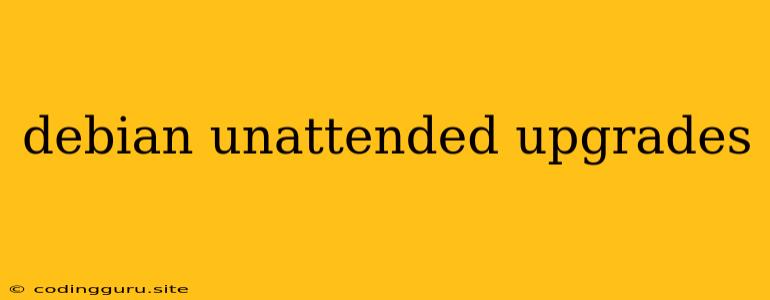Keeping Your Debian System Secure and Up-to-Date with Unattended Upgrades
Maintaining a Debian system can be time-consuming, especially when it comes to keeping it secure and up-to-date. With countless vulnerabilities discovered regularly, it's essential to patch your system promptly. However, manually managing updates can be tedious and often forgotten. That's where Debian unattended upgrades come to the rescue.
What are Debian Unattended Upgrades?
Debian unattended upgrades are a powerful tool that automatically updates your system's packages in the background. It handles security updates and essential bug fixes without requiring any manual intervention. This feature ensures your system is constantly protected from potential threats and vulnerabilities.
How Do Unattended Upgrades Work?
The unattended-upgrades package is a crucial component of this automated update process. It checks for available updates periodically and automatically downloads and installs them. This package also provides various configuration options allowing you to customize the behavior of updates, such as:
- Frequency: You can set how often updates are checked and applied.
- Automatic Reboot: You can configure automatic reboots after installing updates.
- Blacklist: You can exclude specific packages from being updated.
- Whitelist: You can specify packages to be always updated.
Setting Up Unattended Upgrades
Enabling unattended upgrades on your Debian system is a straightforward process. Follow these steps:
- Install the Package: Begin by installing the unattended-upgrades package using the following command:
sudo apt install unattended-upgrades
- Configure the Settings: Now, you need to configure the settings for the unattended-upgrades service. Open the configuration file using your preferred text editor:
sudo nano /etc/apt/apt.conf.d/50unattended-upgrades
- Configure Update Frequency: Set the frequency of updates by adding the following lines to the configuration file:
APT::Periodic::Update-Package-Lists "1";
APT::Periodic::Download-Upgradeable-Packages "1";
APT::Periodic::Unattended-Upgrade "1";
These lines specify that the system checks for updates daily (1). You can adjust these values according to your needs.
- Automatic Reboots (Optional): You can enable automatic reboots after installing updates by adding these lines:
APT::Periodic::AutocleanInterval "7";
APT::Periodic::Download-Upgradeable-Packages "1";
APT::Periodic::Unattended-Upgrade "1";
- Blacklist/Whitelist (Optional): To exclude or include specific packages from being updated, use the following format:
Unattended-Upgrade::Allowed-Origins "{$ORIGIN}";
Unattended-Upgrade::Allowed-Origins "{$ORIGIN} $SECURE_ORIGIN";
Unattended-Upgrade::Blacklist "package_name";
Unattended-Upgrade::Whitelist "package_name";
- Configure Root Password: You need to provide the root password for unattended-upgrades to complete the update process. This is done using the following command:
sudo dpkg-reconfigure unattended-upgrades
Follow the prompts to set the password.
- Verify the Setup: To confirm your configuration, run the following command:
sudo systemctl status unattended-upgrades
You should see the service running and ready to automatically update your system.
Tips for Unattended Upgrades
- Test the Setup: It's recommended to initially test the configuration by running a manual update before enabling automatic updates:
sudo apt update && sudo apt upgrade -y
- Monitor Logs: Keep an eye on the log files to ensure that the unattended upgrades are working properly:
/var/log/unattended-upgrades/
- Security Best Practices: Always ensure your system is up-to-date with security updates.
- Backup: Regularly back up your system's data to ensure your data is safe in case of unforeseen issues.
Conclusion
Debian unattended upgrades are an essential tool for keeping your system secure and up-to-date. By automating the update process, you can save time and effort while ensuring your system is protected from potential vulnerabilities. Remember to configure it carefully, monitor the system, and follow best practices to ensure optimal performance and security.
